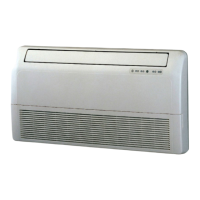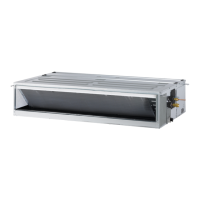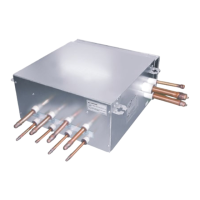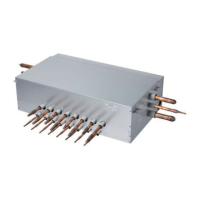32 Outdoor Unit
Refrigerant piping installation
Thermal insulation of refrigerant piping
Steel wire
Piping
Asphaltic oily mastic or asphalt
Heat insulation material A
Outer covering B
Heat
insulation
material A
Outer
covering B
Glass fiber + Steel wire
Adhesive + Heat - resistant polyethylene foam +
Adhesive tape
Indoor Vinyl tape
Floor exposed
Water-proof hemp cloth + Bronze asphalt
Outdoor
Water-proof hemp cloth + Zinc plate + Oily paint
Note:
When using polyethylene cover as covering material, asphalt roof-
ing shall not be required.
• Do not insulate gas or low pressure pipe and liquid or high
pressure pipe together.
• Be sure to fully insulate connecting portion.
Liquid pipe
Gas pipe
Electric wire
Finishing tape
Insulating material
Bad example
Good example
These parts are not insulated.
B
A
C
D
E
A
B
C
D
E
A
C
D
D
E
E
F
E
B
A
C
A
B
C
D
E
Transmission cable
F
Transmission cable
F
Liquid pipe
Gas pipe
Electric wire
Finishing tape
Insulating material
A
B
C
D
E
Transmission cable
F
Liquid pipe
Gas pipe
Electric wire
Finishing rectangular pipe
Insulating material
A
B
C
D
E
A
A
B
F
A
E
F
B
D
C
E
Be sure to give insulation work to refrigerant piping by covering liquid pipe and gas pipe separately with
enough thickness heat-resistant polyethylene, so that no gap is observed in the joint between indoor unit
and insulating material, and insulating materials themselves. When insulation work is insufficient, there is a
possibility of condensation drip, etc. Pay special attention to insulation work to ceiling plenum.
1m1m
A
B
D
F
G
B
G
D
B
H
I
J
A
E
B
I
A
B
D
C
Inner wall (concealed)
Floor (fireproofing)
Penetrating portion on fire
limit and boundary wall
Roof pipe shaft
Outer wall Outer wall (exposed)
Penetrations
Sleeve
Heat insulating material
Lagging
Caulking material
Band
Waterproofing layer
Sleeve with edge
Lagging material
Mortar or other incombustible caulking
Incombustible heat insulation material
When filling a gap with mortar, cover the
penetration part with steel plate so that
the insulation material will not be caved in.
For this part, use incombustible materials
for both insulation and covering.(Vinyl
covering should not be used.)

